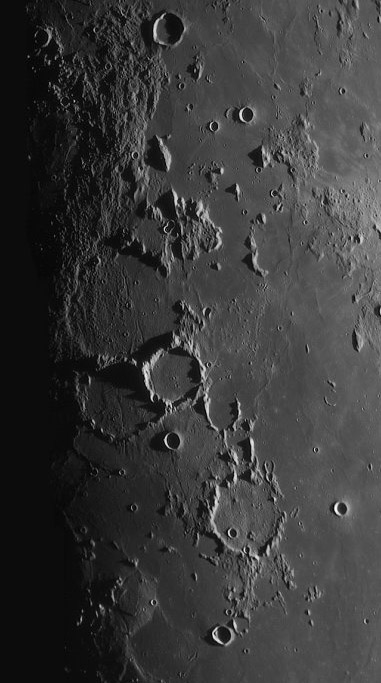|
|
| (4 intermediate revisions by the same user not shown) |
| Line 1: |
Line 1: |
| | __NOTOC__ | | __NOTOC__ |
| | =An Imbrium Ray?= | | =An Imbrium Ray?= |
| | + | <!-- Start of content --> |
| | <div class="post" id="post-1496"> | | <div class="post" id="post-1496"> |
| | | | |
| Line 6: |
Line 7: |
| | <p>[[File:ImbriumRay-Lammel.jpg|ImbriumRay-Lammel.jpg]]<br /> | | <p>[[File:ImbriumRay-Lammel.jpg|ImbriumRay-Lammel.jpg]]<br /> |
| | <em>image by [mailto:slamm@blueyonder.co.uk Stefan Lammel], Uxbridge, England. The putative ray, from Gambart to Guericke.</em></p> | | <em>image by [mailto:slamm@blueyonder.co.uk Stefan Lammel], Uxbridge, England. The putative ray, from Gambart to Guericke.</em></p> |
| − | <p>All fresh craters have rays, demonstrating that during the crater-forming process some rock fragments receive more energetic ejections than others. Did the formation of impact basins also create rays? I would expect so, but it is sort of hard to tell. Crater rays are most conspicuous where they are on dark mare surfaces, but most of the mare lavas erupted after the formation of the last basins. Thus much of the ejecta of the Imbrium Basin has been buried by lavas of Frigoris, Serenitatis, Vaporum, Insularum and Procellarum. Areas where the ejecta are thicker than average (or higher in elevation) have escaped marial burial. These areas - the Haemus Mountains and the [http://www.lpod.org/?m=20070208 Lost Peninsula] - are mostly near Imbrium. One 700 km long nearly continuous deposit of Imbrium ejecta does exist. It extends from near Copernicus, passes Gambart, and extends on to Fra Mauro, disappearing just south of Guericke. Light discoloration of the surface of Mare Nubium suggests that the ejecta might even have continued another 200 km, but has since been buried by lavas. Is this a ray, or just the only remaining piece of what was once a laterally continuous ejecta deposit?</p> | + | <p>All fresh craters have rays, demonstrating that during the crater-forming process some rock fragments receive more energetic ejections than others. Did the formation of impact basins also create rays? I would expect so, but it is sort of hard to tell. Crater rays are most conspicuous where they are on dark mare surfaces, but most of the mare lavas erupted after the formation of the last basins. Thus much of the ejecta of the Imbrium Basin has been buried by lavas of Frigoris, Serenitatis, Vaporum, Insularum and Procellarum. Areas where the ejecta are thicker than average (or higher in elevation) have escaped marial burial. These areas - the Haemus Mountains and the [[February_8,_2007|Lost Peninsula]] - are mostly near Imbrium. One 700 km long nearly continuous deposit of Imbrium ejecta does exist. It extends from near Copernicus, passes Gambart, and extends on to Fra Mauro, disappearing just south of Guericke. Light discoloration of the surface of Mare Nubium suggests that the ejecta might even have continued another 200 km, but has since been buried by lavas. Is this a ray, or just the only remaining piece of what was once a laterally continuous ejecta deposit?</p> |
| | <p>[mailto:tychocrater@yahoo.com Chuck Wood]</p> | | <p>[mailto:tychocrater@yahoo.com Chuck Wood]</p> |
| | <p><strong>Technical Details:</strong><br /> | | <p><strong>Technical Details:</strong><br /> |
| Line 13: |
Line 14: |
| | Rükl plates 42 & 43<br /> | | Rükl plates 42 & 43<br /> |
| | [http://www.pbase.com/slammel/moon Stefan’s website]<br /> | | [http://www.pbase.com/slammel/moon Stefan’s website]<br /> |
| − | Part of this image, at full resolution, appeared as [http://www.lpod.org/?m=20070622 LPOD] on June 11, 2007.</p> | + | Part of this image, at full resolution, appeared as [[June_22,_2007|LPOD]] on June 11, 2007.</p> |
| − | <p align="center"><em>Get ready for Christmas giving and support LPOD when you buy ANY book from Amazon thru [http://www.lpod.org/?page_id=591 LPOD!]</em></p> | + | <p><b>Yesterday's LPOD:</b> [[November 4, 2007|A Swath of Mystery]] </p> |
| | + | <p><b>Tomorrow's LPOD:</b> [[November 6, 2007|Brightness Amid the Gray]] </p> |
| | + | <!-- Removed reference to store page 2 --> |
| | </div> | | </div> |
| − | ---- | + | <!-- End of content --> |
| − | ===COMMENTS?===
| + | {{wiki/ArticleFooter}} |
| − | Register, and click on the <b>Discussion</b> tab at the top of the page.
| |




